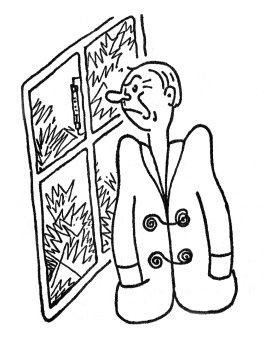“Even January is not a time for idleness in the garden,” say the handbooks on gardening. Certainly not; for in January the gardener
CULTIVATES THE WEATHER.
There is something peculiar about the weather; it is never quite right. Weather always shoots over the mark on one side or the other. The temperature never reaches the hundred years’ normal; it is either five degrees [Celsius] below or five degrees above. Rainfall is either ten millimetres below the average or twenty millimetres above; if it is not too dry, it is inevitably too wet.

If people who are not concerned with the weather have so many reasons for complaining about it, what should a gardener say! If too little snow falls, he grumbles that it reaches nowhere; if too much, he says that he is afraid that it will break his conifers and hollies. If there is no snow, he complains of pernicious black frosts; if the thaw sets in, he curses the mad winds which come with it, and have the damnable habit of upsetting his brushwood and other coverings in the garden, or perhaps, devil take them! will even break the trees. If the sun dares to shine in January the gardener is on tenterhooks lest the bushes will burst into bud too soon. If it rains, he fears for his little Alpine flowers; if it is dry, he thinks with pain on his rhododendrons and andromedas. And yet it would be so easy to satisfy him. It would be quite nice if from the first of January it were nine-tenths of a degree below zero, one hundred and twenty-seven millimetres of snow (light and, if possible, fresh), rather cloudy, calm, or with mild winds from the West; and all would be well. But nobody minds us gardeners, and nobody asks us what things ought to be. That’s why the world is as it is. ❖
—By Karel Čapek, from The Gardener’s Year.


 Previous
Previous

